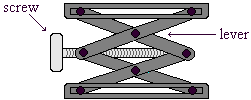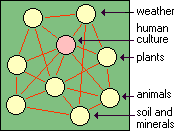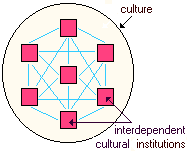All cultures change through time. No culture is
static. However, most cultures are basically conservative in that they tend to resist
change. Some resist more than others by enacting laws for the preservation and
protection of traditional cultural patterns while putting up barriers to alien ideas and
things. For example, the French government has forbidden the commercial use of
English words for which there are French equivalencies. This is a reaction
particularly to the widespread use and popularity of terms such as "sandwich"
and "computer" among young people. More
recently, Starbucks has found it very difficult to become established in
France despite the fact that it is becoming successful elsewhere in Europe.
In contrast, some cultures are extremely open to some kinds of change.
Over the last two decades, the Peoples Republic of China has been rapidly
adopting western technology and culture in everyday life. This can be
seen in their wide acceptance of everything from cell phones to American
television shows and fast food. McDonald's has already established 560
of their restaurants in China and soon will be adding 100 more. KFC
fried chicken franchises have been even more popular. There are 1000
KFC outlets throughout the country with more than 100 in Beijing alone.
Taco Bell, A & W, and Pizza Hut are not far behind. In 2003, the
Chinese government made the decision to require all children in their
country, beginning with the 3rd grade of elementary school, to learn
English. This will very likely accelerate westernization.
China is far from being unique in
experiencing a revolutionary rate of change. It
is now abundantly clear that we are in an accelerating culture change period all around the world
regardless of whether we try to resist it or not. It is driven by the expansion of international commerce and
especially mass media. Ultimately, what is driving it is our massive human
population explosion. The number of people in the world now doubles in less than
half a century.
What Actually Changes When
Cultures Change?
| |
 |
| |
21st century jack
based on principles
of physics known to the ancient Greeks |
When analyzing the transformation
of a culture, it is clear that different understandings are gained depending
on the focus. Anthropology began its study of this phenomenon, during the late 19th
century, largely from the perspective of trying to understand how
manufactured things, such as tools,
are invented and modified in design over time. It became apparent that there rarely are
entirely new inventions. Most often, only the function, form, or principle is new,
but not all three. For instance, our modern jack, used for lifting up the side of a
car, is usually based on the principles of the lever and/or the screw. Those principles
were well known to the ancient Greeks more than 2,000 years ago.
By the
1940's, anthropologists began to realize that ideas, tools,
and other artifacts generally are not
invented or changed in isolation. They are the product of particular cultural
settings. Cultures are organic wholes consisting of interdependent components.
Inventions often occur in response to other cultural changes.
Likewise,
inventions potentially can affect all cultural institutions. Beginning in the
1950's, for instance, televisions in American homes affected how and when members of
families interacted with each other. Less time was available for direct
conversation. The size of houses in more affluent
areas of the U.S. are now usually
2-3 times larger than they were
in the 1950's. As a consequence, family members often have their own
rooms and become even more isolated from each other.

|
|
Parents with
few children
can give more personal
attention to each of them |
Similarly, the introduction of new, effective birth
control measures, mostly beginning in the early 1960's, allowed people to easily limit the
number of children they had and to space their births. This affected the
relationships of children with their parents and siblings. When
there are fewer
children, parents can give more attention to each one. Likewise, more money per
child is available for clothes, entertainment, gifts, and education. Potentially,
there is also more money and leisure time for parents when there are fewer children in
their family.
| |
 |
North
American father
in a non-traditional role:
caring for his child while
his wife works elsewhere |
|
The
interrelated nature of cultural institutions can also be seen in the effects of changing
roles for American women since the mid-20th century. As they have increasingly moved
into the work force outside of the home, it has given them financial independence and has
altered traditional roles within the family. Men are less essential as bread winners
and less accepted as patriarchs. They have
begun to take on more child rearing and other domestic household responsibilities
previously defined as "women's work." Divorce has become an economically
viable alternative for women in unhappy marriages. There also has been a marked
decrease in the frequency of mother-child interaction. American children have increasingly
been raised by non-family members in child care centers and schools.

|
|
Culture
and the natural
environment are interrelated
in complex ways |
|
By
the early 1960's, it was evident to some anthropologists that cultures do not exist in
isolation. When cultures change, they can have major impacts on the
environment. Similarly, when the environment changes, there are likely
to be impacts on culture. For example, global
warming at the end of the last ice age, 10,000 years ago,
very likely was a major contributing factor
leading to the invention of agriculture. This technological innovation allowed for
such immense increases in human populations that we began to rapidly alter the environment
by depleting resources. In the vicinity of ancient cities, forests often were cut
down for construction materials and fuel and wild animals were hunted to
near extinction for food.
Since 1985, the average number of people living together
in a household has been dropping in the 76 richest nations due to increased
affluence and other social changes. Extended and joint family
households are less popular. Divorce rates have gone up usually
resulting in the establishment of new households by one or both former
marriage partners. There also are larger numbers of unmarried adults
who establish their own households. For a quarter century there
has been a demand for housing that is significantly over what would be
expected from the population growth in these nations. As a result, the
need for lumber and other construction materials has caused a dramatic
increase in the exploitation of forests. This in turn makes it
increasingly more difficult to maintain global biological diversity.
The
interrelationship between culture and environment also can be seen in our depletion of
energy resources and forced adoption of new energy sources. As wood became
relatively scarce by the beginning of the Industrial
Revolution in Europe, it was replaced by coal to fuel factories
and heat homes. In turn, coal
began to be replaced by oil and natural gas during the early 20th century. The
increasing costs associated with petroleum products have now caused it to begin to be
replaced by nuclear, solar, and other energy sources.
Human
economies change as necessity forces us to alter our relationship with the
environment. As our economies change, the rest of culture changes in
response. We are now facing potential major global cultural changes
over the next century as a result of the greenhouse
effect that is presumably being caused or aggravated by the
accelerated burning of fossil fuels and forest products. The result likely will be
progressive global warming, shifting climates, and flooded coastal regions. Entire
island nations in the Pacific and Indian Oceans may disappear below the sea.
Actually, this process of
people changing the global climate may have begun much earlier than the
beginning of the Industrial Revolution as it has been commonly thought.
William Ruddiman of the University of Virginia has evidence indicating that
the rise of global temperatures began about 8,000 years ago with the
early spread of agriculture. He suggests that the massive clearance of
forests in Europe and Asia for farming beginning at that time released huge amounts of greenhouse gases into the atmosphere.
In his estimation, this
was enough warming to put off an impending ice age.
It
is now clear that culture change is very complex. It has far ranging causes and
effects. In order to understand all of the manifestations of change, we must take a holistic
 approach to studying cultures and the environments
in which they exist. In other words, we must assume that human existence can be understood
only as a multifaceted whole. Only then can we hope to understand the phenomena of
culture change.
approach to studying cultures and the environments
in which they exist. In other words, we must assume that human existence can be understood
only as a multifaceted whole. Only then can we hope to understand the phenomena of
culture change.




